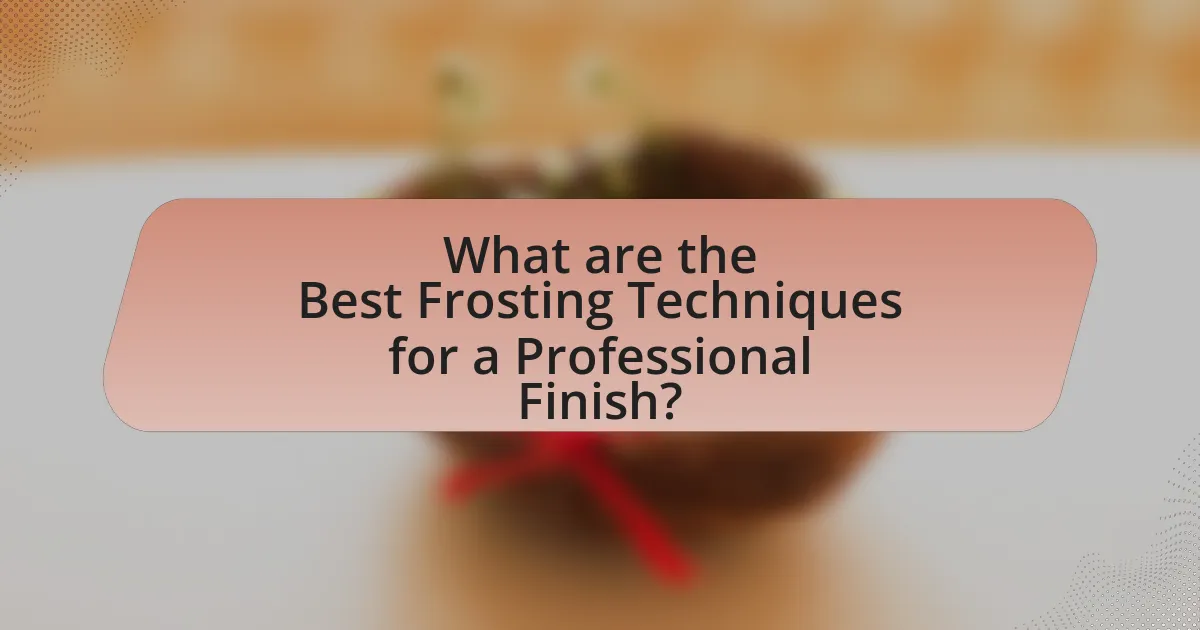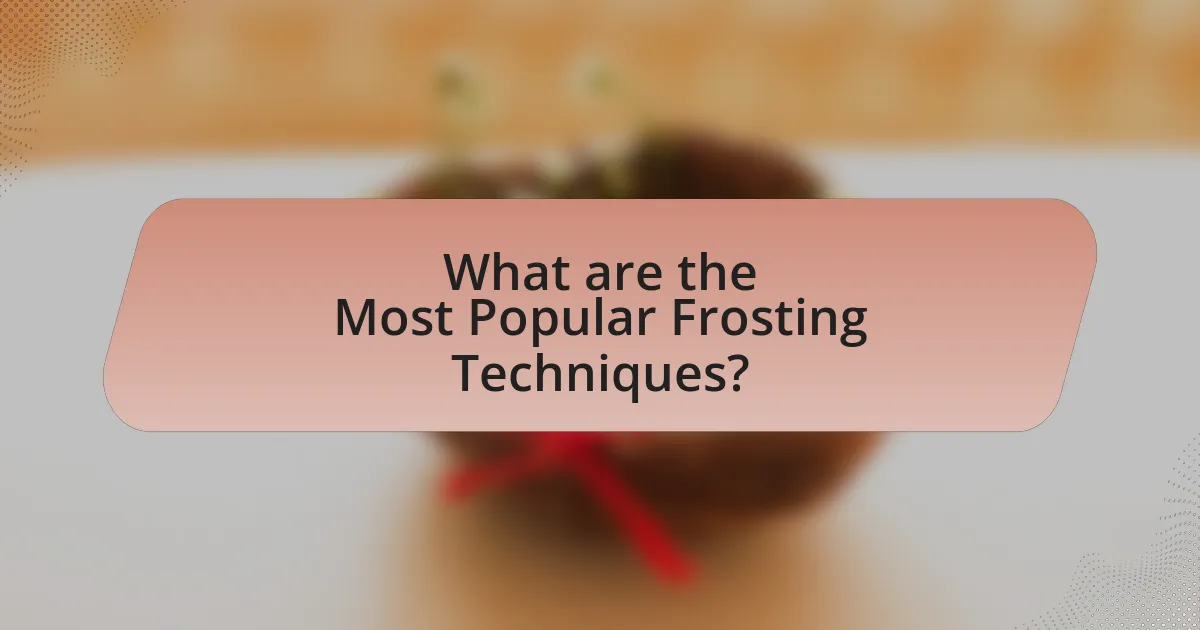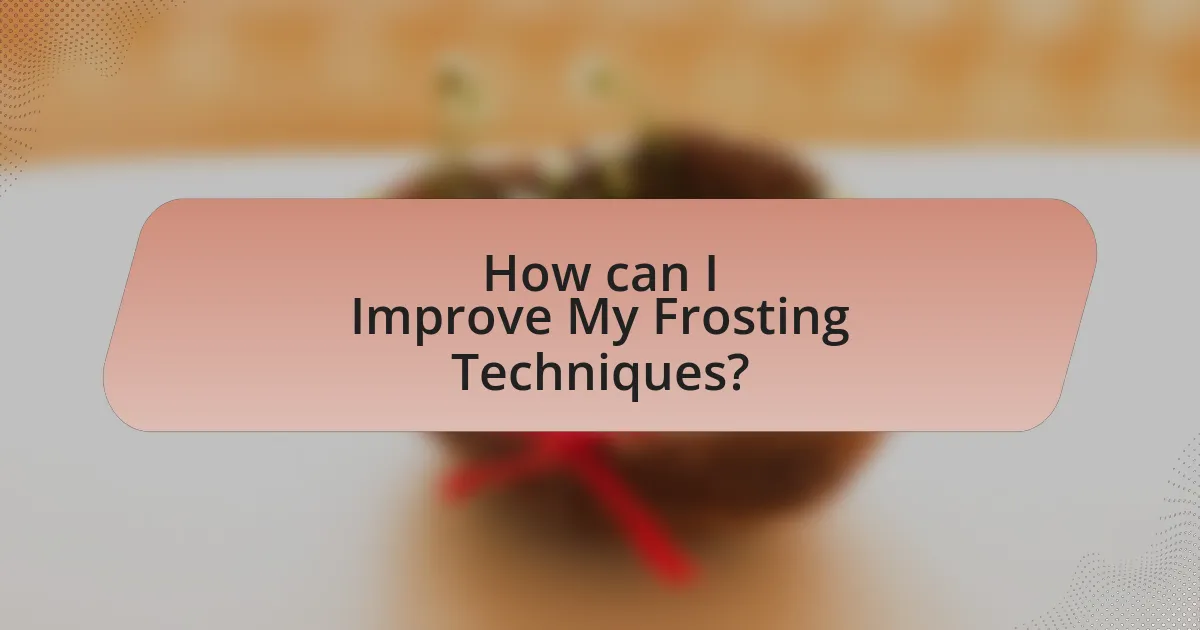The article focuses on the best frosting techniques for achieving a professional finish in cake decoration. It outlines essential methods such as using a spatula for smooth application, piping bags for decorative designs, and bench scrapers for even edges. The impact of different frosting techniques on a cake’s appearance, texture, and overall quality is discussed, emphasizing the importance of mastering these skills for bakers. Additionally, the article covers popular frosting styles, common mistakes to avoid, and best practices for achieving flawless finishes, providing a comprehensive guide for enhancing frosting techniques in professional baking.

What are the Best Frosting Techniques for a Professional Finish?
The best frosting techniques for a professional finish include using a spatula for smooth application, employing a piping bag for decorative designs, and utilizing a bench scraper for even edges. A spatula allows for a clean and even layer of frosting, which is essential for a polished look. Piping bags enable intricate designs and patterns, enhancing the visual appeal of the cake. A bench scraper helps achieve straight edges and a uniform height, contributing to a professional appearance. These techniques are widely used by professional bakers to ensure that cakes not only taste great but also look visually stunning.
How do different frosting techniques impact the overall appearance of a cake?
Different frosting techniques significantly impact the overall appearance of a cake by altering its texture, color distribution, and visual appeal. Techniques such as smooth spreading create a sleek, polished look, while piping techniques can add intricate designs and patterns, enhancing the cake’s aesthetic complexity. For instance, a cake decorated with rosettes or ruffles appears more elaborate and festive compared to a simple, flat frosting application. Additionally, the use of various colors and finishes, such as ombre or marbling, can create striking visual effects that draw attention. Research indicates that visual presentation influences consumer perception and enjoyment, highlighting the importance of frosting techniques in cake decoration.
What visual effects can be achieved with various frosting styles?
Various frosting styles can achieve distinct visual effects, enhancing the overall presentation of baked goods. For instance, buttercream frosting can be piped into intricate designs, creating textures like rosettes or ruffles, which add depth and elegance. Fondant provides a smooth, polished finish that can be molded into shapes or draped over cakes for a sleek appearance. Whipped cream offers a light, airy look, ideal for soft, romantic presentations. Additionally, ganache can create a glossy, reflective surface, giving cakes a luxurious finish. Each frosting style not only serves a decorative purpose but also influences the perceived texture and flavor profile of the dessert.
How does the choice of frosting technique influence the cake’s texture?
The choice of frosting technique significantly influences the cake’s texture by affecting its moisture retention and overall mouthfeel. For instance, a smooth buttercream application creates a creamy texture that enhances the cake’s softness, while a whipped frosting technique introduces air, resulting in a lighter, fluffier texture. Additionally, techniques like fondant covering can create a denser outer layer, which may alter the perception of the cake’s moistness. Research indicates that the type of frosting can also impact how the cake interacts with moisture in the environment, with thicker frostings providing a barrier that helps maintain the cake’s freshness longer.
Why is mastering frosting techniques important for bakers?
Mastering frosting techniques is crucial for bakers because it directly impacts the aesthetic appeal and overall quality of baked goods. Effective frosting techniques enhance the presentation of cakes and pastries, making them more attractive to customers and increasing their marketability. According to a study published in the Journal of Culinary Science & Technology, visually appealing desserts can significantly influence consumer purchasing decisions, with 67% of participants indicating that appearance is a key factor in their choice. Therefore, proficiency in frosting not only elevates the visual aspect but also contributes to the success of a baking business.
What role does frosting play in cake decoration?
Frosting serves as both a decorative and functional element in cake decoration. It enhances the visual appeal of the cake, allowing for artistic designs and textures that attract attention. Additionally, frosting acts as a barrier that helps to retain moisture in the cake, preserving its freshness and flavor. The use of frosting can also provide a contrast in taste and texture, complementing the cake’s base. For instance, a rich chocolate frosting can balance a light vanilla cake, creating a more enjoyable eating experience.
How can frosting techniques elevate a baker’s skills?
Frosting techniques can significantly elevate a baker’s skills by enhancing their ability to create visually appealing and professionally finished baked goods. Mastering various frosting methods, such as piping, smoothing, and layering, allows bakers to showcase their creativity and precision, which are essential in professional baking. For instance, the use of different piping tips can create intricate designs and textures, while techniques like the “ombre” effect can add depth and sophistication to cakes. According to a study published in the Journal of Culinary Science & Technology, bakers who employ advanced frosting techniques report higher customer satisfaction and increased sales, demonstrating the direct impact of these skills on a baker’s success.

What are the Most Popular Frosting Techniques?
The most popular frosting techniques include piping, spreading, and glazing. Piping involves using a piping bag to create decorative designs, which allows for intricate patterns and shapes on cakes and cupcakes. Spreading is a more straightforward method where frosting is applied with a spatula, creating a smooth or textured finish. Glazing, often used for donuts and pastries, involves pouring a thin layer of icing over the baked goods for a shiny appearance. These techniques are widely used in professional baking to enhance the visual appeal and flavor of desserts.
What are the key characteristics of buttercream frosting?
Buttercream frosting is characterized by its creamy texture, sweet flavor, and versatility in use. This frosting is primarily made from butter and powdered sugar, which creates a smooth and spreadable consistency. The high fat content from the butter contributes to its rich taste and stability, allowing it to hold shapes well when piped. Additionally, buttercream can be easily flavored and colored, making it suitable for various cake designs and decorations. Its ability to maintain structure at room temperature further enhances its popularity in professional baking.
How can buttercream be flavored and colored effectively?
Buttercream can be flavored and colored effectively by incorporating extracts, fruit purees, or food colorings. For flavoring, common extracts like vanilla, almond, or citrus can be added in small amounts, typically one teaspoon per cup of buttercream, to achieve a balanced taste. Additionally, fruit purees can provide both flavor and natural color; for instance, raspberry puree can add a fruity flavor and a pink hue.
For coloring, gel food colorings are preferred over liquid ones because they provide vibrant colors without altering the buttercream’s consistency. A small amount, often just a drop or two, can be mixed in until the desired shade is reached. This method ensures that the buttercream maintains its texture while achieving the desired visual appeal.
What are common mistakes to avoid when using buttercream?
Common mistakes to avoid when using buttercream include using cold butter, overmixing, and not sifting powdered sugar. Using cold butter can result in a lumpy texture, as it does not incorporate smoothly with other ingredients. Overmixing can lead to a grainy consistency due to the incorporation of too much air, which affects the final texture. Not sifting powdered sugar can cause lumps in the buttercream, making it difficult to achieve a smooth finish. These mistakes can compromise the quality and appearance of the frosting, impacting the overall presentation of baked goods.
What is the significance of fondant in professional cake decorating?
Fondant is significant in professional cake decorating because it provides a smooth, polished finish that enhances the visual appeal of cakes. This pliable icing can be rolled out and draped over cakes, allowing for intricate designs and shapes that are difficult to achieve with traditional buttercream. Additionally, fondant can be molded into decorative elements such as flowers and figurines, which adds to the cake’s overall artistry. Its versatility and ability to hold color well make it a preferred choice among professional decorators, as it can create a wide range of textures and styles, contributing to the cake’s aesthetic and thematic coherence.
How does fondant differ from traditional frosting?
Fondant differs from traditional frosting primarily in texture and application. Fondant is a smooth, pliable sugar dough that can be rolled out and draped over cakes for a sleek finish, while traditional frosting, such as buttercream, is creamy and spreadable, used for decorating and flavoring. Fondant provides a polished appearance and can be molded into shapes, making it ideal for intricate designs, whereas traditional frosting offers a softer, more flavorful option that is easier to spread but may not achieve the same level of visual smoothness.
What techniques are essential for working with fondant?
Essential techniques for working with fondant include kneading, rolling, and draping. Kneading fondant ensures it reaches a pliable consistency, making it easier to work with. Rolling fondant to an even thickness is crucial for smooth application on cakes, as uneven thickness can lead to tearing or bulging. Draping involves carefully laying the rolled fondant over the cake, allowing it to settle into place without air bubbles. These techniques are foundational for achieving a professional finish, as they directly impact the appearance and texture of the final product.

How can I Improve My Frosting Techniques?
To improve your frosting techniques, practice using an offset spatula for even application and smooth finishes. This tool allows for better control and precision when spreading frosting on cakes and cupcakes. Additionally, ensure your frosting is at the right consistency; it should be spreadable but not too soft, which can be achieved by adjusting the ratio of butter to sugar. Using a turntable can also enhance your technique, as it allows for easier access to all sides of the cake while frosting. According to baking experts, consistent practice with these tools and techniques leads to a more professional finish in frosting applications.
What tools are essential for achieving a professional finish?
Essential tools for achieving a professional finish in frosting techniques include a high-quality offset spatula, a bench scraper, and a turntable. The offset spatula allows for precise spreading and smoothing of frosting, while the bench scraper helps create clean edges and surfaces. A turntable facilitates easy rotation of the cake, enabling even application of frosting from all angles. These tools are commonly used by professional bakers to ensure a polished and visually appealing result.
How do different piping tips affect the final design?
Different piping tips significantly influence the final design of frosting by altering the shape, texture, and detail of the decoration. Each piping tip is designed with a specific opening that creates unique patterns; for example, a star tip produces a textured, star-shaped design, while a round tip allows for smooth lines and dots. The size and shape of the tip directly affect the amount of frosting dispensed and the precision of the application, enabling decorators to achieve intricate designs or bold statements. This versatility is essential for creating professional-looking finishes, as evidenced by the variety of designs achievable with just a few different tips, such as rosettes, shells, and borders.
What are the best practices for using a spatula and bench scraper?
The best practices for using a spatula and bench scraper involve maintaining proper technique and ensuring cleanliness. When using a spatula, hold it at a slight angle to create an even layer of frosting, applying consistent pressure to achieve a smooth finish. For a bench scraper, use it to create sharp edges by pressing it against the sides of the cake while rotating it on a turntable. Clean both tools frequently to prevent cross-contamination and maintain the integrity of the frosting. These practices enhance the overall appearance and texture of the finished product, ensuring a professional look.
What tips can help troubleshoot common frosting issues?
To troubleshoot common frosting issues, ensure the frosting is at the correct temperature, as too cold frosting can be hard to spread, while too warm frosting can be runny. If the frosting is too thick, add a small amount of milk or cream to achieve the desired consistency; conversely, if it is too thin, incorporate more powdered sugar gradually. Additionally, if the frosting is grainy, it may be due to insufficient mixing; continue to beat the frosting until smooth. These tips are effective because they address the primary causes of frosting problems, allowing for adjustments that lead to a better texture and consistency.
How can I fix a runny frosting consistency?
To fix a runny frosting consistency, gradually add powdered sugar until the desired thickness is achieved. This method is effective because powdered sugar absorbs moisture, which helps thicken the frosting. Typically, adding about one tablespoon at a time allows for better control over the consistency, ensuring it does not become too thick.
What should I do if my frosting is too stiff to work with?
To make frosting that is too stiff easier to work with, gradually add small amounts of liquid, such as milk or water, while mixing until the desired consistency is achieved. This method is effective because it allows for precise adjustments without compromising the frosting’s overall structure. For instance, adding one teaspoon of liquid at a time can help achieve a smoother texture, as the liquid integrates into the frosting, softening it without making it runny.
What are the best practices for achieving a flawless finish?
To achieve a flawless finish in frosting, it is essential to use a smooth, well-prepared base cake and high-quality frosting. Starting with a chilled cake helps prevent crumbs from mixing into the frosting, ensuring a clean application. Applying a crumb coat, which is a thin layer of frosting, seals in crumbs and provides a smooth surface for the final layer. Using an offset spatula or a bench scraper allows for even distribution and smoothing of the frosting, while rotating the cake on a turntable aids in achieving uniformity. Additionally, using a heated spatula can help create a polished look by melting the frosting slightly for a smoother finish. These practices are supported by professional bakers who emphasize the importance of preparation and technique in achieving a professional appearance.
How can I ensure even frosting application on my cakes?
To ensure even frosting application on cakes, use a bench scraper or offset spatula to spread the frosting evenly across the surface. This technique allows for consistent thickness and smoothness, which is essential for a professional finish. Additionally, applying a crumb coat—a thin layer of frosting to seal in crumbs—before the final layer helps achieve a smooth surface. Studies in culinary arts emphasize that using a turntable while frosting can also enhance evenness, as it allows for better control and access to all sides of the cake.
What techniques can help create smooth edges and surfaces?
To create smooth edges and surfaces in frosting, techniques such as using a bench scraper, applying a heated spatula, and utilizing a turntable are effective. The bench scraper allows for even pressure and a straight edge, ensuring uniformity. A heated spatula melts the frosting slightly, smoothing out imperfections and creating a polished finish. A turntable facilitates easy access to all sides of the cake, enabling consistent application of frosting. These methods are widely recognized in professional baking, as they enhance the aesthetic quality of the final product.
